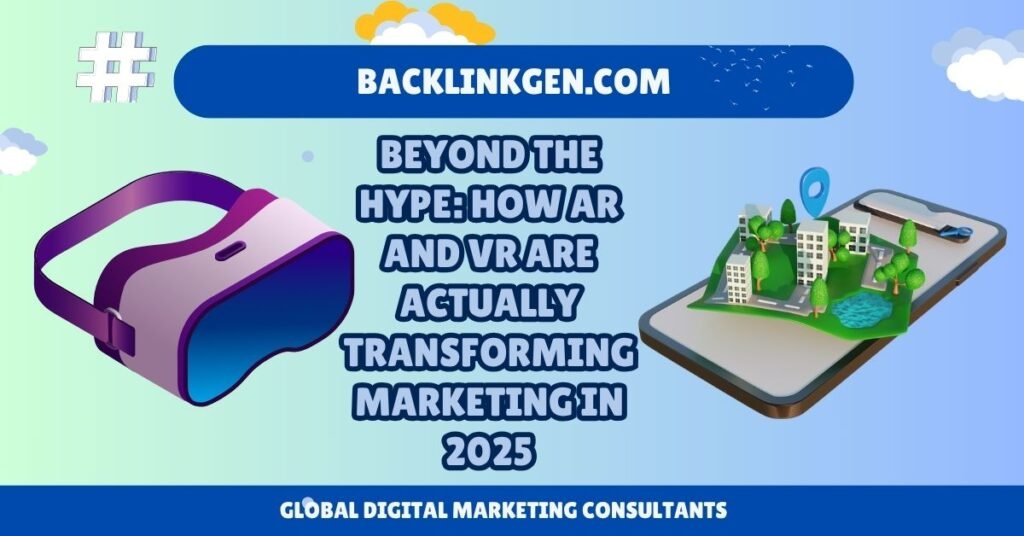By Amit, Digital Marketing Strategist
For years, Augmented Reality (AR) and Virtual Reality (VR) have been the “next big things” in marketing. We’ve seen flashy demos and futuristic promises, but for most businesses, the path to practical implementation has been murky. That era is over.
The conversation has officially shifted from “This is cool” to “This converts.” As a strategist who has integrated these technologies for clients, I’ve moved from cautious experimentation to confident advocacy. The data is now clear: immersive marketing, when executed strategically, isn’t a gimmick—it’s a powerful engine for engagement, conversion, and brand loyalty.
Let’s cut through the hype and explore the tangible AR and VR trends that are reshaping the marketing landscape right now.
❌ First, Let’s Demystify the Jargon
- Augmented Reality (AR): Overlays digital elements onto the real world through your phone’s camera or smart glasses. Think: trying on sunglasses via a website or seeing a virtual couch in your actual living room.
- Virtual Reality (VR): Immerses the user in a completely digital environment, typically using a headset. Think: a virtual test drive of a car or a tour of a hotel resort from your home.
For most marketers today, AR offers the most immediate and scalable opportunities.
🔥 The 4 AR & VR Trends Driving Real ROI in 2025
1. The “Try-Before-You-Buy” Revolution (AR Commerce)
This is the single most powerful application of AR for e-commerce brands. It directly addresses the biggest online shopping pain point: uncertainty.
- How it Works: Customers use their smartphone camera to visualize products in their own space or on their person.
- Real-World Impact:
- Furniture & Home Decor: IKEA Place and Wayfair’s app allow users to place true-to-scale 3D models of furniture in their homes. The result? A significant reduction in product returns and a dramatic increase in buyer confidence.
- Beauty & Apparel: Sephora’s “Virtual Artist” lets users try on thousands of lipstick shades and eyeshadows. Warby Parker allows you to try on glasses frames virtually. This functionality bridges the online-offline gap, effectively bringing the fitting room to the customer.
- The Bottom Line: Brands using AR see conversion rates increase by up to 94% for users who engage with AR features compared to those who don’t.
2. Interactive Product Storytelling (Immersive Demos)
Some products are difficult to explain with photos and text alone. AR and VR can bring their features and benefits to life.
- How it Works: Instead of a static PDF, a B2B company can create an interactive AR experience. Point your phone at a product brochure, and a 3D model of the industrial machine appears on the page, which you can rotate, zoom into, and even trigger animations to see how its components work.
- Real-World Impact: An IT consultancy client used a simple AR demo to explain the complex architecture of a cloud security system. This transformed their sales process, making an abstract concept tangible for non-technical decision-makers and shortening the sales cycle by an estimated 20%.
3. The Rise of the Virtual Pop-Up and Showroom (VR & WebAR)
Geography and budget are no longer limitations for creating unforgettable brand experiences.
- How it Works: Brands can create virtual worlds that users can explore on a VR headset or, more accessibly, directly in their web browser (WebAR). This is perfect for product launches, exclusive events, or showcasing a full product line without physical inventory.
- Real-World Impact: A footwear brand created a virtual sneaker museum to launch a new line. Users could explore the space, learn about the design inspiration, and—crucially—click to buy the products they discovered. This generated massive buzz and captured valuable first-party data from a global audience.
4. Gamified Brand Engagement (AR Filters & Experiences)
This trend leverages the “fun” factor of AR to create shareable, viral moments that build brand awareness and affinity.
- How it Works: Creating branded filters on platforms like Instagram, Snapchat, and TikTok, or developing simple AR games tied to a marketing campaign.
- Real-World Impact: A beverage company might create a filter that surrounds the user with animated characters from their brand world. A paint company could create a game where users “throw” virtual color at a wall to reveal a prize. These campaigns drive user-generated content, increase social media engagement, and make your brand part of the conversation.
🛠️ Getting Started: Your No-Code Immersive Marketing Toolkit
You don’t need a Hollywood-level budget or an in-house development team to start.
- For Simple AR Product Visualizations: Platforms like Threekit or Augment allow you to upload 3D models of your products and generate AR codes for your website.
- For Creating Social Media Filters: Spark AR (for Meta) and Lens Studio (for Snapchat) are free, powerful platforms with extensive learning resources. You can build a custom filter in an afternoon.
- For Building Virtual Showrooms: Tools like Mozilla Hubs or Spatial offer user-friendly ways to create shared virtual spaces that are accessible via a simple web link.
🚨 The Critical Mindset Shift for Success
The biggest mistake I see is treating AR/VR as a standalone campaign. For it to be effective, it must be seamlessly integrated into your existing marketing funnel.
- Awareness: Use social AR filters to grab attention.
- Consideration: Deploy AR “try-on” features on your product pages to reduce friction.
- Conversion: Place clear CTAs within your VR showroom to guide users to purchase.
- Loyalty: Use immersive experiences to deliver exclusive content or advanced product training to existing customers.
“The goal of immersive marketing isn’t to show off technology. It’s to use technology to remove doubt, create delight, and build a deeper, more memorable connection with your customer.”
– Amit
Is Your Brand Ready for the Immersive Leap?
The transition to immersive marketing can feel daunting. The key is to start with a clear objective: What specific business problem are you trying to solve? Is it reducing returns? Explaining a complex service? Generating buzz?
At my consultancy, we cut through the complexity and help you build a pragmatic, ROI-focused strategy. We’ll help you identify the right use case, select the most cost-effective tools, and integrate immersive experiences into a marketing funnel that delivers measurable results.
Don’t just watch the future of marketing happen—shape it.
Connect with us for a complimentary Digital Marketing Consulting session. We’ll analyze your current strategy and explore how immersive technologies like AR and VR can drive tangible growth for your business.
Schedule Your Free Consultation Now
About Amit: With a focus on practical, results-driven strategies, Amit helps businesses leverage emerging technologies to build predictable growth engines. His expertise lies in cutting through the hype to implement solutions that deliver a clear return on investment.

